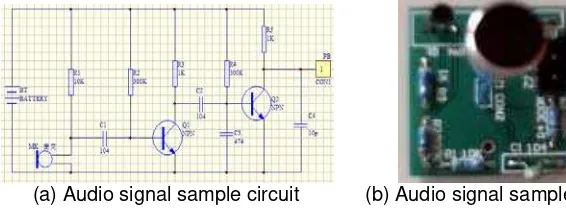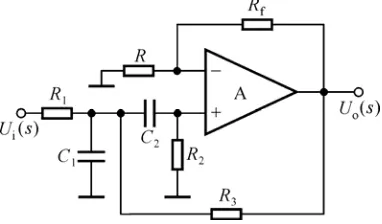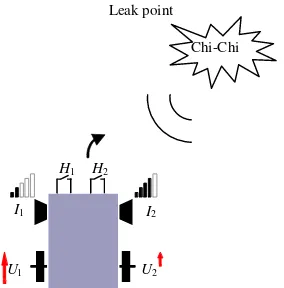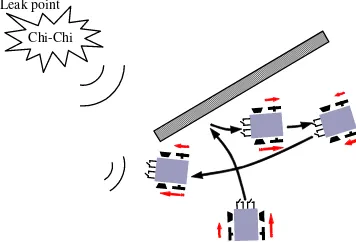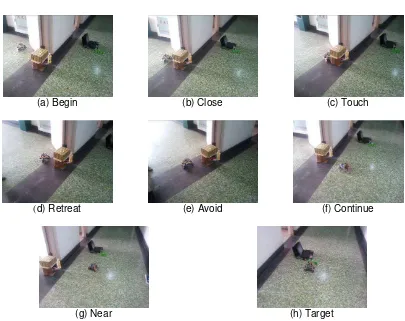DOI: 10.12928/TELKOMNIKA.v14i3A.4404 169
An Audio Guided Resource Robot Based on Band-pass
Filter and Touch Sensors
Bokai Xuan1*, Lina Zhao1,2, Peng Wang1, Hao Sun1
1
School of Control Engineering, Hebei University of Technology, Tianjin, 300130, P. R. China
2Network Center, Civil Aviation University of China, Tianjin, 300130, P. R. China
*Corresponding author, e-mail: [email protected]
Abstract
A rescue robot guided by visual sensors cannot find its path and target in the environment full of smoke or fog. It makes the danger disposal task of rescue robot difficult, especially the task of pipeline leakage disposal in a chemical factory. In this paper, a rescue robot guided by audio sensors is presented. As audio signals can bypass obstacles and remedy the shortcomings of visual and other sensors, it can guide the robot to the sound source according to the difference of sound field strength between two audio sensors. And band-pass filters are equipped alone the audio sensor input ports for tracing the special frequency sound signals emitted by the pipeline leakage. Besides, touch sensors are designed for the obstacle avoidance. Some typical experiments support the effects of approach in this paper.
Keywords: Audio Guided robot, Band-pass Filter, Touch Sensor, sound signal
Copyright © 2016 Universitas Ahmad Dahlan. All rights reserved.
1. Introduction
Robots play important role in danger disposal cases in earthquake or fire. The navigation of danger disposal robot in the complex unknown environment is the key point. It is an important application branch of SLAM research [1]. If a pipeline leak happens in chemical factory, there will be high density toxic smoke and fog in a large range, which makes it danger and difficult for human to locate the leak point or rescue the survivals. And the robots may provide aids.
At present, the navigation of mobile robots mainly depends on the vision and/or ultra-sonic, laser, infrared sensors [2]. As the wave length of light, ultra-sonic and infrared signals are very short, the diffraction property is weak. So the conditions behind the obstacles or walls are impossible to be detected. Moreover, the dense smoke and fog always make the robots with visual navigation system hard to seek the target and feasible path.
Different from the signals above, the audio signal has longer wave length, and stronger diffraction property. There are some significant advantages in audio navigation. The sound signals can bypass the obstacles and walls even in smoke and fog.
Human can determine the direction of sound by analyzing the difference of sound intensity and time delay of two ears. The same principle could be simulated to make robot ears [3, 4]. In [5], an audio array composed of 8 audio sensors is presented for sound direction by analyzing the time delay of sound signals. In [6], particle filter method is used for location of the sound source behind the obstacles. A humanoid robot with audio location function is studied in Tokyo University [7]. Besides, a high precision audio guided mobile robot prototype is designed in Taiwan Jiaotong University [8]. And a regular tetrahedron structure microphone array that can locate 3-D distance and angular was proposed in [10].
There are two fundamental manners for microphone array-based sound source location, the manner of time delay of arrival (TDOA) and the manner of inter-aural level difference (ILD). Both manners work effectively [10-13].
The paper is organized as follows. The audio signal sample and band-pass filter is introduced in the second section. The third section presents the detailed audio navigation method for danger disposal robot based on band-pass filter, as well as the measure for obstacle avoidance. And the experiment results are shown in fourth section. The conclusion is drawn in the final section.
2. Audio Band-Pass Filter 2.1. Audio Signal Sample Unit
To locate the leak point alone the pipeline in chemical factory is a typical task for danger disposal. Based on the correct location result, the robot can move to recover the fault. However, the high density toxic smoke and fog leaked from the pipes hinder the mobile robots vision for navigation and location, whereas the audio navigation method can overcome it.
There are two key points in the design of robot audio signal sample unit. The first one is the sensitivity. And the second point is the anti-interference ability. To meet with the requirement above, an audio sensor circuit is designed, which is composed of signal input part and band-pass filter part. The audio sensor circuit is shown in Figure 1, in which a high sensitive microphone is used. Furthermore, there is a two-grade signal amplifying structure in the circuit, which makes the audio sensor obtain higher sensitivity.
(a) Audio signal sample circuit (b) Audio signal sample unit
Figure 1. Audio sensor circuit
The noise is another key point should be considered. In the audio navigation of the robot, the noise in the environment disturber the sound source location. The noises, like human voice, motor working and/or machine vibration always have different frequency spectrum distributions. Whereas, the sound, “Chi-Chi-Chi”, emitted from the pipeline leak point always has a special frequency and band width. For example, the sound frequency from a 3~5mm hole on a 50mm diameter pipe with 5~8 atmospheric pressure gas in it mainly concentrate from 2000Hz to 3000Hz. According to this feature, a band-pass filter might be used to eliminate the interference of noise in the environment. So the robot could trace the special frequency sound caused by the pipe leakage and reach the target point. The band-pass filter might be digital or analog type.
2.2. Digital Band-Pass Filter
Digital band-pass filter has ideal anti-interfere performance. Besides, the band-pass cut-off frequency could be regulated easily and preciously. However, the digital processing is hard to be describe in a assemble language for single chip micro-processor, especially the Fourier transformation. With the development of DSP and embedded system technologies, it is easier than before and is used widely.
An ideal digital filter could be realized by using Fourier transformation to obtain the frequency spectrum.
) sin cos
( 2 ) (
1 0
l n b l n a a x
f x n x
n n
Discretization is done to make the Fourier transformation feasible in a microprocessor. Set N points in the periodic interval (0,2l).
2
Make further transformation, there is
According to the typical frequency of sound emitted from the leak point on the pipeline, the cut-off frequency f1 and f2 are set. Then set the factor Ck as 0 for all the frequency part
except the band-pass from f1 to f2. Then the high and low frequency parts exceeding the
band-pass scope are eliminated, with the inner parts are kept. So the outer-band noise could be eliminated. And the program is available in Internet.
2.3. Analog Band-Pass Filter
An analog band-pass filter circuit might simplify the signal processing program and improve the real-time response speed. Moreover, the frequency band width of the sound from a leak point on the pipeline is not certain. It may change with the pipeline diameter, leak hole, and the pressure. The parameters of hardware filter are easy to tune via the regulation of potentiometers.
Take the circuit in Figure 2 as an example. The proportional factor is
1
Set the middle frequency
1
And the cutoff frequencies are
Regulating the Rf, R, and C, the cutoff frequencies and band width scope would be
tuned.
Figure 2. 2-orderl band-pass filter circuit
3. Robot Audio Navigation 3.1. Audio Guidance
A behavior-based audio navigation system for mobile robot is shown in Figure 3. The left and right microphones receive the audio signals and transform it into electric signals respectively. Then band-pass filters are used to cut off the high and low frequency noise. Next, the intensity of two-way signals are input and computed respectively. Take the example in Figure 3 for instance, as the sound emitted from the leak point on a pipe line is not only near but also straight to the right microphone, so the right microphone receives stronger signal then the left microphone, which is denoted as I2>I1. And the driving voltage U1 and U2 of the two wheels
are output according to the equations below.
2
Chi-Chi Leak point
U1
U2
I1 I2
H1 H2
Figure 3. Audio navigation of mobile robot
Because I2 is larger than I1, so U2 is larger than U1. Accordingly, the speed of the motor
amounted on the left wheel is faster than the right one. Then the robot would turn its running direction towards the sound source. It is vice versa when the sound source lies on the left side of robot. Whereas the robot faces straight to the sound source, the input signal intensity of two microphones and the output voltage of two motors are both equal. So the robot would move forward towards to the sound source. To sum up, the robot could be guided by the audio navigation system and reach the sound source in the end.
The factor k in Eq.12 and 13 is not constant in the control process of the mobile robot. When the robot is far away from the sound source, the sound intense level is low, and k might be large. The k should be reduced alone with the decrease of the distance to the sound source. Or the output and the driving motor would be saturation and lost the function of direction adjusting.
For danger disposal, the spaces are usually badly damaged into mess with irregular obstacles. The model based navigation approach can hardly work in such poor environment. While the behavior-based navigation approach fits well for the non-structure space. Although the efficiency might be low, the final effect is satisfied.
3.2. Obstacle Avoiding
As far as the obstacle is concerned, there are two flexible touch sensors H1 and H2
mounted in the front of robot. The obstacle avoidance control strategy is shown in Table 1.
Table 1. Obstacle avoidance control strategy
H1 H2 Control value Motion
off off U1KI2
1
2 K I
U Forward
on off U11.5KI2
1 2 0.2K I
U Turn right
off on U10.2KI2
1 2 1.5K I
U Turn left
on on U1KI1
2
2 K I
U Backward
Chi-Chi Leak point
Figure 4. One side obstacle avoidance of mobile robot
3.3. Dead Lock
If both touch sensors are pressed, that means the obstacle is in the front of the robot like a wall. It might cause the dead lock in the robot moving control. Dead lock in the motion control of mobile robot means a robot runs into a trap of touching the obstacle, running backward and leaving the obstacle, then running forward and touching the obstacle again, and running backward and leaving the obstacle…… to and fro with no end. It is usually found in the autonomous mobile robot.
In Table 1, the dead lock issue is solved as shown in Figure 5. Before the obstacle is touched, the two wheels of robot run at the proportional rate of contralateral audio sensor signal. When there is an obstacle in front, the robot run back-ward with the two wheels running at the rate of ipsilateral audio sensor signal in the next 3 seconds. So the posture of robot in the backward way is different from the posture of robot in the forward way. When 3-second retreat is over, the robot has regulated its posture for a new direction and continues its tracing toward the sound source. And no dead lock would occur continually.
Chi-Chi Leak point
Figure 5. Front obstacle avoidance of mobile robot
4. Results and Analysis
In the experiment, a mobile robot equipped with ARM10 microprocessor is used. Two-way A/D ports with band-pass filter are used for audio signals sampling. Besides, two PWM output ports are used to drive the two wheels.
(a) The robot at the start point (b) Trace
(c) Turn (d) Door passing
(e) Go on tracing (f) Keep tracing
(g) Near (h) Target point
Figure 6. Front obstacle avoidance of mobile robot
The robot is guided by audio signals and traces the sound source out of invisible scope little by little without any visual sensor. Finally, the robot arrives at the target point successfully. So it can be used in danger disposal for pipeline leak happens in chemical factory.
(a) Begin (b) Close (c) Touch
(d) Retreat (e) Avoid (f) Continue
(g) Near (h) Target
Figure 7. Obstacle avoidance experiment
5. Conclusions
The sound signals can bypass the obstacles and walls. And it can spread through heavy smoke and fog alone a winding path by reflection and diffraction. So, an audio navigation system for the danger disposal robot can remedy the inadequacy of visual, ultrasonic and infrared sensors. In this paper, a band-pass filter based audio navigation system is proposed to trace the special frequency sound caused by the pipe leakage. And the experiment shows ideal result.
Besides, the robot navigation approach proposed in this paper is a kind of sensor direct driving manner. It is more like a behavior-based control rather than a model-based control. It might seem simple with low academic contribution. However, the danger disposal environment is seldom ideal structure space for model-based control. The approach in this paper does work more effectively than those complicated programmed robot.
Combined with the hexapod crawling driven, voice recognition, or other sensors and the multi-sensor fusion technology, the audio navigated robot may obtain higher performance in the field of danger deposal and rescue in the ruins of earthquake.
Acknowledgements
This work is supported by the by NSF of China 61174009, 61305101 and 61503118.
References
[1] T Sutikno, M Facta, GRA Markadeh. Progress in Artificial Intelligence Techniques: from Brain to Emotion. TELKOMNIKA (Telecommunication Computing Electronics and Control). 2011; 9(2): 201-202.
[3] Jiang J, Zhao J, Li LK. Sound-based Collaborative Direction Estimation for Swarm Robotic Systems.
ACAT Automatica SINICA. 2007; 33(4): 385-390.
[4] John EA. Optimal filtering and speech recognition with microphone arrays. Dissertation: Brown University, Providence, US. 2001.
[5] Jean MV, Francis M. Robust Sound Source Localization Using a Microphone Array on a Mobile Robot. in Proc. of IEEE RSJ 2003, Las Vegas. 2003: 23-30.
[6] Jean V, Francis M, Jean R. Robust localization and tracking of simultaneous moving sound sources using beam forming and particle filtering. Robotics and Autonomous Systems. 2007; 55(3): 216–228. [7] HU Mingxia. Intrusion Detection Algorithm Based on BP Neural Network. Computer Engineering.
2012; 38(6): 148-150.
[8] Yang YH, Huang HZ, Shen QN, Wu ZH, Zhang Y. Research on Intrusion Detection Based on Incremental GHSOM. Chinese Journal of Computers. 2014; 37(5): 1216-1224.
[9] Curkendall DW, Mareynolds SR. A Simplified Approach for Determining the Information Content of Radio Tracking Data. Journal of Spacecraft. 1969; 6 (5): 520-525.
[10] Sree MK, Subrahmanyam K. Retail Web System Upgrading with Strategic Customer Using Threshold Policy. Journal of Telematics and Informatics. 2015; 3(1): 28-32.
[11] Chen WX, Zhang CY. Location System of Impact Point Based on Acoustics Detecting Technique.
Ordnance Industry Automation. 2009; 28(4): 36-38.
[12] Z. Li, Z. Huang, Y. Huang. Design of Spot Welding Robot. TELKOMNIKA Indonesian Journal of Electrical Engineering. 2013; 11(11): 6267-6273.
[13] Jin BA, Feng H, Wang CC. Preparation of 10 MHz Band stop Crystal Filter. Piezo Electectrics and Acoustooptics. 2009; 31(2): 204-206.
[14] Miao Y, Yu-Ping W. Coverage Repair Strategies for Wireless Sensor Networks using Mobile Actor Based on Evolutionary Computing. Bulletin of Electrical Engineering and Informatics. 2014; 3(3): 213-222.
[15] Sun H, Liu ZJ, Yang P, Dong AL. Audio navigation of rescue robots based on speech recognition.
